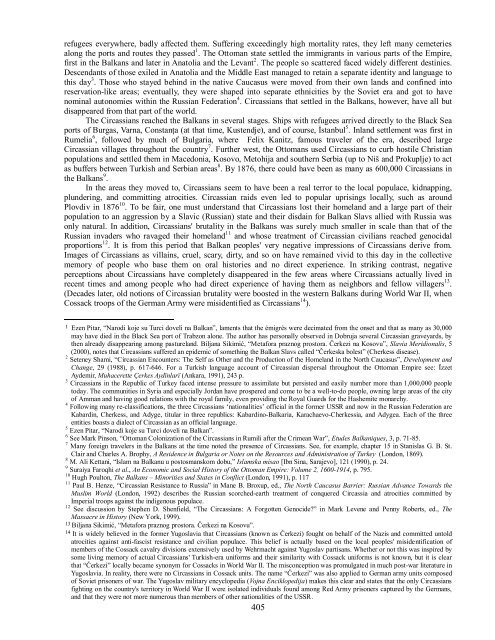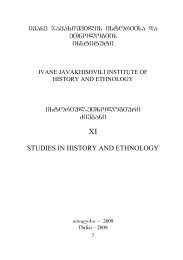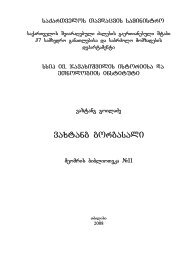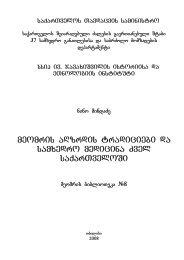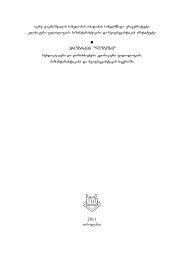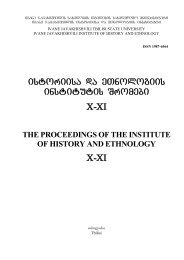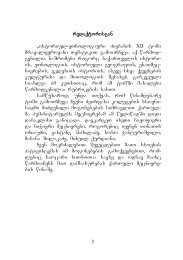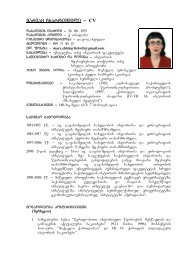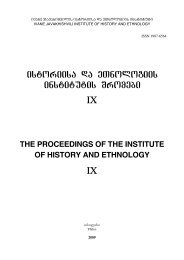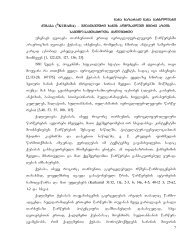axali da uaxlesi istoria
axali da uaxlesi istoria
axali da uaxlesi istoria
You also want an ePaper? Increase the reach of your titles
YUMPU automatically turns print PDFs into web optimized ePapers that Google loves.
efugees everywhere, badly affected them. Suffering exceedingly high mortality rates, they left many cemeteries<br />
along the ports and routes they passed 1 . The Ottoman state settled the immigrants in various parts of the Empire,<br />
first in the Balkans and later in Anatolia and the Levant 2 . The people so scattered faced widely different destinies.<br />
Descen<strong>da</strong>nts of those exiled in Anatolia and the Middle East managed to retain a separate identity and language to<br />
this <strong>da</strong>y 3 . Those who stayed behind in the native Caucasus were moved from their own lands and confined into<br />
reservation-like areas; eventually, they were shaped into separate ethnicities by the Soviet era and got to have<br />
nominal autonomies within the Russian Federation 4 . Circassians that settled in the Balkans, however, have all but<br />
disappeared from that part of the world.<br />
The Circassians reached the Balkans in several stages. Ships with refugees arrived directly to the Black Sea<br />
ports of Burgas, Varna, Constanţa (at that time, Kustendje), and of course, İstanbul 5 . Inland settlement was first in<br />
Rumelia 6 , followed by much of Bulgaria, where Felix Kanitz, famous traveler of the era, described large<br />
Circassian villages throughout the country 7 . Further west, the Ottomans used Circassians to curb hostile Christian<br />
populations and settled them in Macedonia, Kosovo, Metohija and southern Serbia (up to Niš and Prokuplje) to act<br />
as buffers between Turkish and Serbian areas 8 . By 1876, there could have been as many as 600,000 Circassians in<br />
the Balkans 9 .<br />
In the areas they moved to, Circassians seem to have been a real terror to the local populace, kidnapping,<br />
plundering, and committing atrocities. Circassian raids even led to popular uprisings locally, such as around<br />
Plovdiv in 1876 10 . To be fair, one must understand that Circassians lost their homeland and a large part of their<br />
population to an aggression by a Slavic (Russian) state and their dis<strong>da</strong>in for Balkan Slavs allied with Russia was<br />
only natural. In addition, Circassians' brutality in the Balkans was surely much smaller in scale than that of the<br />
Russian invaders who ravaged their homeland 11 and whose treatment of Circassian civilians reached genoci<strong>da</strong>l<br />
proportions 12 . It is from this period that Balkan peoples' very negative impressions of Circassians derive from.<br />
Images of Circassians as villains, cruel, scary, dirty, and so on have remained vivid to this <strong>da</strong>y in the collective<br />
memory of people who base them on oral histories and no direct experience. In striking contrast, negative<br />
perceptions about Circassians have completely disappeared in the few areas where Circassians actually lived in<br />
recent times and among people who had direct experience of having them as neighbors and fellow villagers 13 .<br />
(Decades later, old notions of Circassian brutality were boosted in the western Balkans during World War II, when<br />
Cossack troops of the German Army were misidentified as Circassians 14 ).<br />
1 Ezen Pitar, “Narodi koje su Turci doveli na Balkan”, laments that the émigrés were decimated from the onset and that as many as 30,000<br />
may have died in the Black Sea port of Trabzon alone. The author has personally observed in Dobruja several Circassian graveyards, by<br />
then already disappearing among pastureland. Biljana Sikimić, “Metafora praznog prostora. Čerkezi na Kosovu”, Slavia Meridionalis, 5<br />
(2000), notes that Circassians suffered an epidemic of something the Balkan Slavs called “Čerkeska bolest” (Cherkess disease).<br />
2 Seteney Shami, “Circassian Encounters: The Self as Other and the Production of the Homeland in the North Caucasus”, Development and<br />
Change, 29 (1988), p. 617-646. For a Turkish language account of Circassian dispersal throughout the Ottoman Empire see: Ïzzet<br />
Aydemir, Muhacerette Çerkes Aydïnlarï (Ankara, 1991), 243 p.<br />
3 Circassians in the Republic of Turkey faced intense pressure to assimilate but persisted and easily number more than 1,000,000 people<br />
to<strong>da</strong>y. The communities in Syria and especially Jor<strong>da</strong>n have prospered and come to be a well-to-do people, owning large areas of the city<br />
of Amman and having good relations with the royal family, even providing the Royal Guards for the Hashemite monarchy.<br />
4 Following many re-classifications, the three Circassians ‘nationalities’ official in the former USSR and now in the Russian Federation are<br />
Kabardin, Cherkess, and Adyge, titular in three republics: Kabardino-Balkaria, Karachaevo-Cherkessia, and Adygea. Each of the three<br />
entities boasts a dialect of Circassian as an official language.<br />
5 Ezen Pitar, “Narodi koje su Turci doveli na Balkan”.<br />
6 See Mark Pinson, “Ottoman Colonization of the Circassians in Rumili after the Crimean War”, Etudes Balkaniques, 3, p. 71-85.<br />
7 Many foreign travelers in the Balkans at the time noted the presence of Circassians. See, for example, chapter 15 in Stanislas G. B. St.<br />
Clair and Charles A. Brophy, A Residence in Bulgaria or Notes on the Resources and Administration of Turkey (London, 1869).<br />
8 M. Ali Kettani, “Islam na Balkanu u postosmanskom dobu,” Islamska misao [Ibn Sina, Sarajevo], 121 (1990), p. 24.<br />
9 Suraiya Faroqhi et al., An Economic and Social History of the Ottoman Empire: Volume 2, 1600-1914, p. 795.<br />
10 Hugh Poulton, The Balkans – Minorities and States in Conflict (London, 1991), p. 117<br />
11 Paul B. Henze, “Circassian Resistance to Russia” in Mane B. Broxup, ed., The North Caucasus Barrier: Russian Advance Towards the<br />
Muslim World (London, 1992) describes the Russian scorched-earth treatment of conquered Circassia and atrocities committed by<br />
Imperial troops against the indigenous populace.<br />
12 See discussion by Stephen D. Shenfield, “The Circassians: A Forgotten Genocide?” in Mark Levene and Penny Roberts, ed., The<br />
Massacre in History (New York, 1999).<br />
13 Biljana Sikimić, “Metafora praznog prostora. Čerkezi na Kosovu”.<br />
14 It is widely believed in the former Yugoslavia that Circassians (known as Čerkezi) fought on behalf of the Nazis and committed untold<br />
atrocities against anti-fascist resistance and civilian populace. This belief is actually based on the local peoples' misidentification of<br />
members of the Cossack cavalry divisions extensively used by Wehrmacht against Yugoslav partisans. Whether or not this was inspired by<br />
some living memory of actual Circassians' Turkish-era uniforms and their similarity with Cossack uniforms is not known, but it is clear<br />
that “Čerkezi” locally became synonym for Cossacks in World War II. The misconception was promulgated in much post-war literature in<br />
Yugoslavia. In reality, there were no Circassians in Cossack units. The name “Čerkezi” was also applied to German army units composed<br />
of Soviet prisoners of war. The Yugoslav military encyclopedia (Vojna Enciklopedija) makes this clear and states that the only Circassians<br />
fighting on the country's territory in World War II were isolated individuals found among Red Army prisoners captured by the Germans,<br />
and that they were not more numerous than members of other nationalities of the USSR.<br />
405


